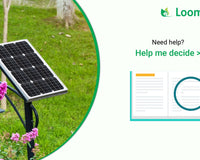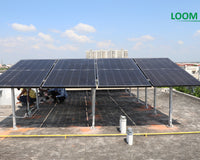The Rooftop Solar Scheme, also known as the PM Surya Ghar Muft Bijli Yojana, is a flagship program launched by the Indian government to encourage the adoption of solar energy systems among residential consumers. Under this scheme, households can install solar photovoltaic (PV) panels on their rooftops to generate electricity for their own consumption, thereby reducing their dependence on traditional grid-based power. Under the Rooftop Solar Scheme, the government extends generous subsidies to facilitate the installation of solar panels, making renewable energy solutions accessible to all households. These subsidies aim to offset the initial investment costs, making solar adoption financially feasible for a wide range of consumers.
How much of the subsidy is available?
The subsidy amount varies based on the capacity of the solar system installed. For households opting for additional capacity beyond 2 kW but up to 3 kW, the subsidy amount is Rs. 18,000 per kW. This incremental subsidy encourages consumers to consider larger solar setups, thereby maximizing energy generation potential. For systems exceeding 3 kW in capacity, the total subsidy amount is capped at a maximum of Rs. 78,000. This upper limit ensures that even larger installations receive substantial financial support from the government, incentivizing the adoption of solar energy on a broader scale.
How to Apply for a Rooftop Solar Scheme?
The application process for the PM Surya Ghar Yojana is streamlined and accessible to all eligible consumers. Prospective beneficiaries can follow a simple step-by-step guide to apply for the scheme:
Step 1: Register on the official portal (https://pmsuryaghar.gov.in) by providing necessary details such as state, electricity distribution company, consumer number, mobile number, and email address.
Step 2: Login to the portal and fill out the application form for rooftop solar installation.
Await feasibility approval and proceed with the installation by engaging registered vendors.
Step 3: Upon installation completion, submit plant details and apply for a net meter.
Step 4: After inspection by the electricity distribution company (DISCOM) and commissioning, provide bank account details for subsidy disbursal.
Step 5: Receive subsidy amount in the bank account within 30 days of submission.
Loan Facility for Solar System Installation
Recognizing the initial investment required for installing solar systems, the government has facilitated access to collateral-free, low-interest loan products for eligible consumers. Financial institutions offer loans at attractive rates, making solar energy adoption financially viable for households. Individuals can avail loans of up to Rs. 2 lakhs with an interest rate as low as 7%, making it an affordable investment in sustainable energy.
Here's a comprehensive overview of the loan details provided by various banks participating in the PM Surya Ghar Muft Bijli Yojana:
Is the Solar Subsidy Amount Uniform Across India?
Yes, the subsidy under this scheme is uniform across India. Customers can apply for state subsidy schemes as well to get additional financial assistance.













1 comment
SsSssa
https://www.facebook.com/Ember.Ghee.Male.Enhancement/
https://knowt.com//note/19eb0629-5da0-49aa-a73b-800f375e9970/Ember-Ghee-Male-Enhancement-Mens-Healt
https://knowt.com//note/3f68b784-e585-459d-91d6-2cb0e5a74942/Ember-Ghee-Male-Enhancement-For-ED-Impro
https://knowt.com//note/734b6a20-46f6-450a-bafc-a48b1760ecbb/Ember-Ghee-In-Penis-Enlargement-Does-It
https://knowt.com/note/875be46a-dcb7-46da-b1d4-fa24867335e0/Ember-Ghee-Dietary-Supplement—-Pills-Fo
https://colab.research.google.com/drive/1VdAC1bxjwjPEadVYhEp6T9Hoobk6L36M?usp
https://colab.research.google.com/drive/1vyaYxrY-OGzKEaOKxLSq2WDmNLdFZFNU?usp
https://colab.research.google.com/drive/1XwFrbIj-0wGNIZ7kIqEWME8B5bPcYeXk?usp
https://colab.research.google.com/drive/1AX0og0XMmMlnPpUu5HteHeO7J6-UvAnZ?usp
https://colab.research.google.com/drive/1AQ9As9BEarifyR8ta5qLAwFZ8OFWtJ_2?usp
https://emberghee.omeka.net/
https://emberghee.omeka.net/ember-ghee-for-ed
https://emberghee.omeka.net/ember-ghee-pills
https://emberghee.omeka.net/ember-ghee-male-enhancement
https://emberghee.omeka.net/ember-ghee-reviews
https://colab.research.google.com/drive/1hm3PizoeMgvr2uE0sKlcKzu9OSr7tXaM?usp
https://colab.research.google.com/drive/1a4KIZmBpMsxuUgp36FFtmqW338G0bnOn?usp
https://www.facebook.com/Vitality.Male.Enhancement/
https://www.facebook.com/VirileFlowMaleEnhancement
https://www.facebook.com/Velotal/
https://www.facebook.com/Velotal.Male.Enhancement/
https://doesthephoenixeddevicework.omeka.net/
https://doesthephoenixeddevicework.omeka.net/does-the-phoenix-ed-device-work
https://doesthephoenixeddevicework.omeka.net/the-phoenix-erectile-dysfunction-device
https://thephoenixerectiledysfunctiondevice.omeka.net/
https://thephoenixerectiledysfunctiondevice.omeka.net/the-phoenix-erectile-dysfunction-device
https://thephoenixerectiledysfunctiondevice.omeka.net/does-the-phoenix-ed-device-work
https://knoxformen.omeka.net/
https://knoxformen.omeka.net/knox-47-for-men
https://knoxformen.omeka.net/knox-47-reviews
https://balancenz.omeka.net/
https://balancenz.omeka.net/glyco-balance-new-zealand
http://balanceau.omeka.net/
https://balanceau.omeka.net/glyco-balance-australia
https://lycocare.omeka.net/
https://lycocare.omeka.net/glyco-care
https://www.facebook.com/Endurix.ME/
https://knowt.com//note/7a29e6a2-96c5-41ca-b055-1b1821b40819/Endurix-Male-Enhancement-Uses-Dosage
https://knowt.com//note/963f3411-c688-406d-8691-7afaafbfd1a1/Endurix-For-Men-Male-Enhancement—Is-It-
https://knowt.com//note/2bceeefb-dcb4-4e24-8bdd-08ad09cbf010/Endurix-In-Penis-Enlargement-Does-It-W
https://colab.research.google.com/drive/1H83iPdIWoJQqFIIUFKybGK3KZdSMX1wk?usp
https://colab.research.google.com/drive/1SWXzNWDgnlggrgh9XjHutFZDRBwM7gVF?usp
https://colab.research.google.com/drive/1SWXzNWDgnlggrgh9XjHutFZDRBwM7gVF?forum
https://colab.research.google.com/drive/1JTygnRB32apNyhZXapEdJ3VOqO5nhJ3g?usp
https://endurix.omeka.net/
https://endurix.omeka.net/endurix-pills
https://endurix.omeka.net/male-libido-supplement